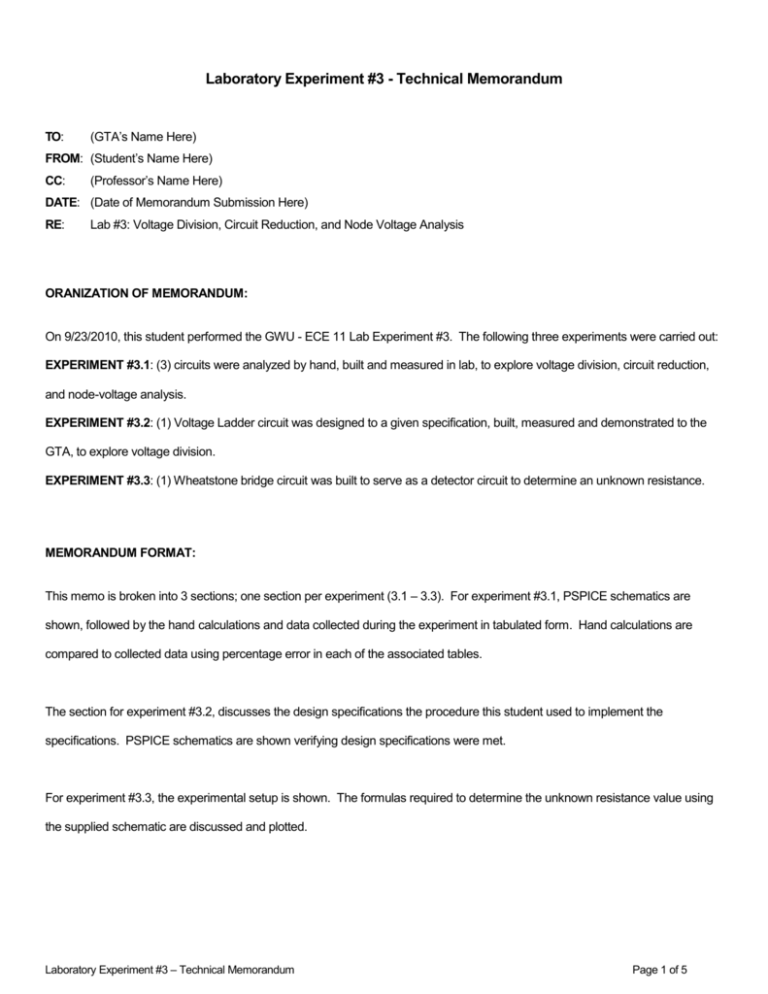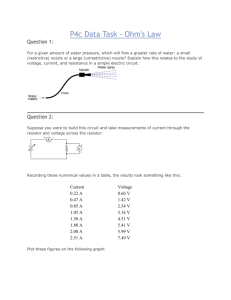Memo
advertisement

Laboratory Experiment #3 - Technical Memorandum TO: (GTA’s Name Here) FROM: (Student’s Name Here) CC: (Professor’s Name Here) DATE: (Date of Memorandum Submission Here) RE: Lab #3: Voltage Division, Circuit Reduction, and Node Voltage Analysis ORANIZATION OF MEMORANDUM: On 9/23/2010, this student performed the GWU - ECE 11 Lab Experiment #3. The following three experiments were carried out: EXPERIMENT #3.1: (3) circuits were analyzed by hand, built and measured in lab, to explore voltage division, circuit reduction, and node-voltage analysis. EXPERIMENT #3.2: (1) Voltage Ladder circuit was designed to a given specification, built, measured and demonstrated to the GTA, to explore voltage division. EXPERIMENT #3.3: (1) Wheatstone bridge circuit was built to serve as a detector circuit to determine an unknown resistance. MEMORANDUM FORMAT: This memo is broken into 3 sections; one section per experiment (3.1 – 3.3). For experiment #3.1, PSPICE schematics are shown, followed by the hand calculations and data collected during the experiment in tabulated form. Hand calculations are compared to collected data using percentage error in each of the associated tables. The section for experiment #3.2, discusses the design specifications the procedure this student used to implement the specifications. PSPICE schematics are shown verifying design specifications were met. For experiment #3.3, the experimental setup is shown. The formulas required to determine the unknown resistance value using the supplied schematic are discussed and plotted. Laboratory Experiment #3 – Technical Memorandum Page 1 of 5 EXPERIMENT #3.1 – Schematics, Calculations, Measured Results, and Percentage Error Figure 1a – Voltage Ladder Circuit Figure 1b – Series / Parallel Circuit Figure 1c – Wheatstone Bridge Circuit Tabulated voltages, currents, power, for individual resistors in circuits from Figures 1a-c: Voltage (V) Current (mA) Power (mW) Calc. Mes. P.E. (%) Calc. Mes. P.E. (%) Calc. Mes. P.E. (%) R1 1.13 1.14 1.06 2.40 2.45 2.08 2.71 2.79 3.17 R2 1.34 1.37 1.93 2.40 2.45 2.08 3.23 3.36 4.06 R3 1.63 1.65 1.10 2.40 2.45 2.08 3.92 4.04 3.21 R4 1.80 1.82 1.11 2.40 2.45 2.08 4.32 Table 1a – Calculated and Measured Data for Circuit in Figure 1a 4.46 3.22 Voltage (V) Current (mA) Power (mW) Calculated Measured % Error Calculated Measured % Error Calculated Measured % Error R1 1.22 1.20 1.53 2.59 2.60 0.27 3.16 3.12 1.27 R2 1.45 1.44 0.83 2.59 2.60 0.27 3.77 3.74 0.56 R3 1.42 1.41 0.97 2.09 2.09 0.18 2.98 2.95 1.15 R4 2.67 2.66 0.40 3.56 3.59 0.81 9.51 9.55 0.41 R5 3.33 3.35 0.62 4.06 4.09 0.74 13.52 13.70 1.36 R6 1.91 1.94 1.81 2.09 2.09 0.18 3.99 Table 1b – Calculated and Measured Data for Circuit in Figure 1b 4.05 1.63 Laboratory Experiment #3 – Technical Memorandum Page 2 of 5 Tabulated voltages, currents, power, for individual resistors in circuits from Figures 1a-c (con’t): Voltage (V) Current (mA) Power (mW) Calculated Measured % Error Calculated Measured % Error Calculated Measured % Error R1 2.34 2.34 0.00 5.00 4.98 0.40 11.70 11.65 0.40 R2 2.40 2.41 0.42 4.29 4.29 0.00 10.30 10.34 0.42 R3 0.06 0.07 2.95 0.10 0.09 4.21 0.01 0.01 1.38 R4 3.66 3.65 0.27 4.88 4.91 0.61 17.86 17.92 0.34 R5 3.60 3.59 0.28 4.38 4.38 0.00 15.77 Table 1c – Calculated and Measured Data for Circuit in Figure 1c 15.72 0.28 Tabulated equivalent resistances and total currents for circuits in figures 1a-c: Req (Ω) Circuit Calculated Total Current (mA) Measured % Error Calculated Measured % Error 1a 2460 2420 1.63 2.40 2.45 2.08 1b 975 964 1.13 6.15 6.17 0.26 9.23 0.75 1c 645 638 1.11 9.30 Table 1d – Calculated data, Measured Data, % Error for Circuits in Figures 1a-c Laboratory Experiment #3 – Technical Memorandum Page 3 of 5 EXPERIMENT #3.2 – Design Discussion, SPICE Simulations, Results Figure 2 – Voltage Ladder Designed, Measured, and Simulated Design Specification: In the second experiment, this student designed a voltage ladder according to following specifications: 5 V DC power supply Voltage drop across resistor 1 (R1) of 0.2 V (±5%) Voltage drop across resistor 2 (R2) of 0.2 V (±5%) Voltage drop across resistor 3 (R3) of 1.6 V (±5%) Voltage drop across resistor 4 (R4) of 3.0 V (±5%) Total consumed power less than or equal to 80 mW Design Discussion: This student used the following procedure to implement the voltage ladder to the specifications given: 1. Calculated ratio of voltage across each resistor to the supply voltage: a. (R1 / 5 V) = 0.04V, (R2 / 5 V) = 0.04 V, (R3 / 5 V) = 0.32 V, (R4 / 5V) = 0.6 V 2. Divide each ratio from step 1, by 0.4 a. Ratio 1 = 0.04 / 0.04 = 1, Ratio 2 = 0.04 / 0.04 = 1, Ratio 3 = 0.32 / .04 = 8, Ratio 4 = 0.32 / .6 = 15 3. Assume kilo-ohm range for resistors a. R1 = Ratio 1 (kΩ) = 1 kΩ, R2 = Ratio 2 (kΩ) = 1 kΩ, R3 = Ratio 3 (kΩ) = 8 kΩ, R4 = 15 kΩ 4. Voltage ladder assembled in PSPICE, shown in figure 2. a. Figure shows specified voltage drops were achieved 5. Total power consumed (1mW), far less than specified: a. 𝑃 = 𝑉2 ∑4 𝑖=1 𝑅𝑖 = 52 25000 = 1 𝑚𝑊 Laboratory Experiment #3 – Technical Memorandum Page 4 of 5 EXPERIMENT #3.3 – Design Discussion, SPICE Simulations, Results Figure 3a – Wheatstone Bridge Detection Circuit Schematic Experiment Setup: Figure 3a shows the experimental setup of the Wheatstone bridge. Potentiometer (R2) was inserted into the bridge to estimate the resistance of an unknown resistor (R5). The potentiometer was adjusted until the voltmeter (V) displayed VBA = 0, indicating a balanced bridge. The ammeter (A) was used to measure current through (R2), so its value could be determined without removing it from the circuit. Analysis of Data: The collected data is shown in table 3a. The formula used to determine R2: (𝑅2 = 𝑉𝑆−(𝑉𝐵𝐴 + 𝑉𝑆 𝑅4 ) 𝑅1 +𝑅4 𝐼𝑅2 ). Figure 3b shows this formula plotted. Finding the tangent to the curve at the point where the curve crosses the VBA = 0 axis, the unknown resistor can be estimated as 5.05 kΩ. The unknown resistance was actually 5.1kΩ. This reveals a < 1 % percentage error indicating that the Wheatstone bridge is a very accurate detection circuit. 3.5 VBA (V) IR2 (mA) VR2 (V) R2 (Ω) 2.99 1.19 0.01 10 2.5 2.49 1.09 0.51 471 2 1.29 0.85 1.71 2009 1.5 0.44 0.68 2.56 3761 0.21 0.64 2.79 4393 0.5 0.04 0.60 2.96 4910 0 -0.31 0.53 3.31 6195 -0.5 0 -0.73 0.45 3.73 8264 -1 -1.03 0.39 4.03 10297 -1.5 -1.12 0.37 4.12 11005 Table 3a - Measured Data Laboratory Experiment #3 – Technical Memorandum 3 VBA (V) 1 2000 4000 6000 8000 10000 12000 R2 (Ω) Figure 3b – Estimation of unknown resistance from measured data Page 5 of 5







